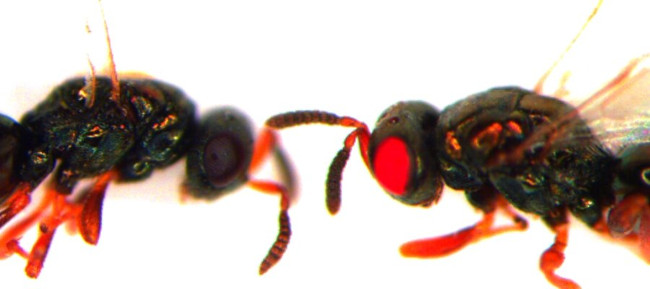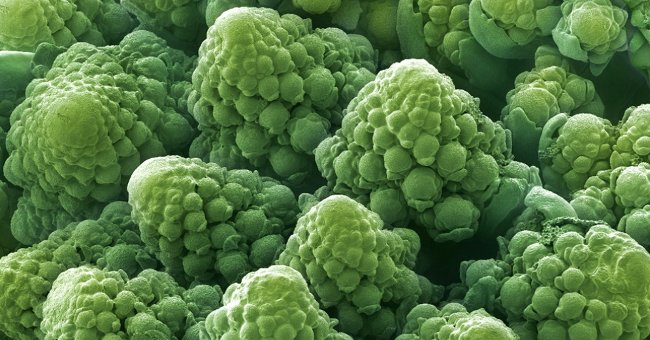Science created a shocking red-eye mutant bee
If one day you suddenly see the red-eyed bees, especially in the Southern California region, don't be too surprised, panicked, they are just sudden bees that University scientists California, Riverside created only.
Accordingly, scientists at the University of California, Riverside have experimented using the technique of cutting CRISPR genes on small insects that specifically bees. The result is a mutant red-eyed bee.
Specifically, CRISPR gene cutting technique allows scientists to directly inject a genetic object created to find and rewrite a specific DNA code. Researchers at UCR have used this technology to break down the eye pigment control genes.
'We want to target a specific eye pigment gene target, just remove that basic pigment, the bees will immediately have red eyes after birth. This is the result of gene disruption ' , - Omar Akbari, an assistant professor of entomology, said in a statement.

CRISPR gene cutting technique requires skilled, extremely high genetic level. Bees hold eggs in the lobe of the intestine, scientists must use invasive techniques with egg bags inside the host's body. Egg bags in bees are usually small in size, only one bean, each egg is one-fourth of that of a grain of rice.
Akbari said: " Basically, you just need to pull out a small target egg, inject it into the ingredients to transform the DNA according to the technique of slicing CRISPR gene and bring it back to the egg bag for it to grow."
This research has just been published on Scientific Reports. And most likely based on the genetically engineered CRISPR gene cutting technique, generations of later bees can easily develop red-eye species.
In new experiments in the future, Akbari and his colleagues want to perform experiments involving genetic coding of other genes in bees, especially the mechanism of body transformation from male to female. some species. Researchers hope that, with the current level of medical science, science can easily control pests that destroy crops and spread diseases.
You should read it
- New Zealand yellow-eyed penguins face extinction
- Listed 10 most terrible experiments on animals
- The most unique and beautiful nest eggs in the world of insects
- What horrible thing will happen to the Earth if the frogs become extinct?
- Do you know how 'honey' bees are?
- 30 hornets massacred 30,000 bees in 3 hours
- Let Justin Schmidt try to feel the pain of being caught by insects with the 'strongest sting in the world'
- Facebook apologizes to users for psychological experiments
May be interested
- White polar bears die because of love loss that many people suffer
 szenja, a 21-year-old polar white bear at seaworld marine park in san diego (usa), was shocked and died after only a few weeks when her companion was a snowflake male.
szenja, a 21-year-old polar white bear at seaworld marine park in san diego (usa), was shocked and died after only a few weeks when her companion was a snowflake male. - Strangely: The beaver becomes the 'leader', leading 150 cows
 a beaver inadvertently strayed into a cattle farm in saskatchewan, canada where the herd of 150 cows was, the unexpected happened, instead of chasing the stranger away from the territory, the herd was obedient. follow the small beaver's tail.
a beaver inadvertently strayed into a cattle farm in saskatchewan, canada where the herd of 150 cows was, the unexpected happened, instead of chasing the stranger away from the territory, the herd was obedient. follow the small beaver's tail. - Super beautiful photos of everyday food are viewed through a microscope
 please join tipsmake.com to observe a bunch of super beautiful photos on daily food that are viewed through the microscope below!
please join tipsmake.com to observe a bunch of super beautiful photos on daily food that are viewed through the microscope below! - The extremely intense battle of two 5-ton male elephants
 huge african elephants are ready to fight together to gain the right to mate with their children.
huge african elephants are ready to fight together to gain the right to mate with their children. - Listed 10 largest species of creatures in the ocean
 not a blue whale, a lion's mane, is the creature with the largest body length in the ocean. when stretching tentacles, lion mane jellyfish can reach a length of about 36.5 m.
not a blue whale, a lion's mane, is the creature with the largest body length in the ocean. when stretching tentacles, lion mane jellyfish can reach a length of about 36.5 m. - Decipher the strange behavior often seen in dogs
 let's learn some of the behaviors that puppies often do to understand more about these close friends of humans.
let's learn some of the behaviors that puppies often do to understand more about these close friends of humans.






 How to use G Shock watch from A - Z
How to use G Shock watch from A - Z Tips for playing Teenage Mutant Ninja Turtles: Shredder's Revenge
Tips for playing Teenage Mutant Ninja Turtles: Shredder's Revenge Please download Hyper Light Drifter and Mutant Year Zero, 2 great action adventure games are free
Please download Hyper Light Drifter and Mutant Year Zero, 2 great action adventure games are free Scientists created a mutant enzyme that 'ate' nearly a ton of plastic bottles after a few hours
Scientists created a mutant enzyme that 'ate' nearly a ton of plastic bottles after a few hours 10+ images of mutant vegetables like radiation
10+ images of mutant vegetables like radiation